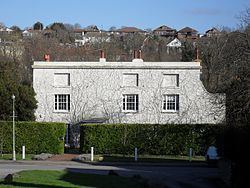Designated as world heritage site 20 August 1971 | Reference no. 1380552 Rebuilt 1835 Restored 1993 | |
 | ||
Similar Percy and Wagner Almshouses, Pelham Institute, 75 Holland Road - Hove, Patcham Pylon, Anthaeum - Hove | ||
Ovingdean Grange is a Grade II listed manor house situated on the south coast of England in the village of Ovingdean, east of Brighton. One of the oldest and most historical residences in Brighton, it gave its name to the novel Ovingdean Grange by the popular 19th-century writer William Harrison Ainsworth.
Contents
History
Ovingdean is a small village just outside Brighton, where Ovingdean Grange is the oldest residence. The oldest building is the 11th-century parish church of St. Wulfran's opposite Ovingdean Grange. Saxon farmhouses were first built in Ovingdean in the 11th century, and no firm evidence exists of when the Grange was first built. It is most likely to have been built circa 1540, by Thomas Geere, a yeoman from Wivelsfield who settled in Ovingdean.
Over much of its history, it has been the Grange's occupant who acted as churchwarden for St. Wulfran's opposite. The north side, which was the original entrance, is the oldest part of the house, with flint walls and stone quoins, just like those of the church.
Over the years the house has seen many changes architecturally. As a Tudor manor house, the Grange had servants' quarters and a cellar below ground. Since then it has been altered, the most noticeable addition being the false Georgian façade in 1824.
The house was used as a family home in the 1900s. From 1945 the Grange was occupied by former Mayor of Brighton and local farmer Frank Masefield Baker, although, owing to the ill health of one of its inhabitants, it eventually fell into disrepair. Brighton Council eventually auctioned it off in 1987. After it had remained empty for eight years, the new owners, Dr. Harry Brunjes and wife Jacquie, undertook extensive renovations in 1993 to restore it to its former state. In 2011, Steve Coogan bought it for £2.45 million.
Ovingdean Grange was listed at Grade II by English Heritage on 20 August 1971. This defines it as a "nationally important" building of "special interest". As of February 2001, it was one of 1,124 Grade II-listed buildings and structures, and 1,218 listed buildings of all grades, in the city of Brighton and Hove.
Lords of the Manor
It is unusual in that from approximately 1170 until 1987 the Lord of the Manor who owned the Grange and its farmlands did not live in the village. Instead, the farm and the Grange were leased to tenants, who then farmed the land. The ownership of the manor estate from 1066 until today is known from legal conveyances and church documents, but knowledge of the identities of the tenant farmers is patchy.
The novel Ovingdean Grange
The Grange is the subject of legend. In 1857, the popular novelist W. Harrison Ainsworth wrote Ovingdean Grange: A Tale of the South Downs, in which he described how the future King Charles II stayed there for less than 24 hours before escaping to France in 1651, fathering a child in the process. King Charles is reported to have sheltered in the chimney breast of the master bedroom.
SS Ovingdean Grange
The Ovingdean Grange was a Houlder Bros steamship in service under that name between 1946 and 1959.
